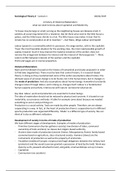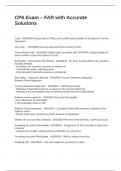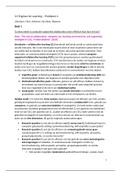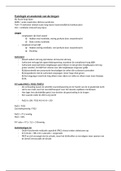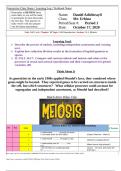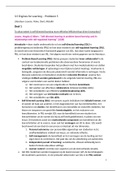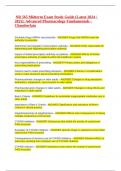A history of Historical Materialism:
what we need to know about Capitalism and Modernity.
“A house may be large or small; as long as the neighboring houses are likewise small, it
satisfies all social requirement for a residence. But let there arise next to the little house a
palace, and the little house shrinks to a hut. The little house now makes it clear that its
inmate has no social position at all to maintain.” – Karl Marx, Wage-Labour and Capital
Labour (power) is a commodity which its possessor, the wage worker, sells to the capitalist.
“Even the most favorable situation for the working class, the most rapid possible growth of
capital, however much it may improve the material existence of the worker, does not
remove the antagonism between his interest and the interest of the bourgeoisie.” – Marx.
Latent conflict between interests of the workers and the capitalist.
Profit and wages are in inverse proportion.
Historical Materialism
Marx and his followers focused on the history of humankind and closely analyzed it in order
to find laws (regularities). There must be laws that control history. It is research-based
theory. In doing so they revolutionized some of the earlier assumptions about history: the
ultimate cause of all social change is to be found, not in the human brain, but in changes in
the mode of production. And also assumptions about human beings: humankind constantly
changes nature through labour, and in doing so, changes itself. Labour is a fundamental
human capacity and activity. Intercourse with nature: we become what we do.
Key idea: labour, work and production are essential to human beings.
The idea of materialism should not be reduced to physical and concrete. It is based on our
materiality, our presence and body. A table for example came about because we needed
something to eat on and put things on.
Production is a social activity. Tools are made by other people. Therefore, we are always
cooperating in a way. In fact, at the heart of production there is cooperation but in different
epochs production was organized differently. ‘Mode’ is a different type of society. We can
think of it also as different civilization.
Development of society in terms of mode of production
We have different stages of development. Examples of modes of production:
- Primitive Communism (hunter-gatherer society): low division of labor, communal
ownership of tools and land, no classes but religion-based authority.
- Ancient slave mode of production (ancient Greece, Mesopotamia, Rome): family-based
economy based on agriculture, class-structured society. Humans (slaves) are the
instruments of production as well as the property of aristocrats.
- Feudalism (medieval Europe): reciprocal and legal obligations between the military lord
(protector) and the vassal (a person granted a possession of land by the lord). Work was
done by surfs, peasants attached to land, and guilds, small workshops set up in towns.
- Capitalism
- Communism (via socialism)
,What are the key components of Capitalism? Private ownership (of the means of
production). Accumulation of capital and wealth in general. Wage labor (“free labour”). Dual
class structure: bourgeoisie and proletariat. Increase in the division of labour/specialization.
The social organization of labor: medieval guilds
Guilds were exclusive, regimented organizations. In order to manage their monopoly and
maintain craft standards, group of skilled craftsmen in the same trade would form
themselves into a guild. The guilds ensured that quality standard were maintained, young
apprentices were trained and journeymen got a fair deal as they traveled and worked to
build up skills and money. The members of the guild were called confraternities, brothers
helping one another. There was a close connection between the guild and the city
authorities.
The ‘Cottage Industry’ as a transition to capitalist economy
Typical system:
- Room dominated but the spinning wheel worked by a woman (springster).
- Took place in a single small house – cottage, where work and life took place simply in
different rooms.
- A lot of land was attached to the cottage and worked by the family. Farming
supplemented profits of spinning and weaving.
- Low skill work with smaller tasks being distributed among different workers.
- Use of women’s and children’s labour.
Novelty became possible with the improvement of the spinning wheel, the instrument and
Independent merchants selling textile products expanded trade to become national (not
only local).
Points to remember:
- Human beings are productive. They work and in laboring they transform nature.
- People’s capacity to produce comes along with the tools they employ and then
techniques they use -> the technological or material side of production. ‘Technology’ in
the most broad sense.
- Humans “produce only insofar as they cooperate in a determinate way and exchange
their activities with one another” (Marx) -> the social side of production (production
relations). Cooperation is coming together, working together which brings about
specialization and division of labour.
- Productive forces determine production relations. Examples: a particular methods of
farming may require larger plots of land and favors large plot land ownership. ICT allows
for working remotely leading to a different configuration of office space.
- Different historical epochs and different societies differ on the basis of how productive
forces fit and relate to productive relations. An example: slavery of the Roman Empire is
not to be equated with the American slavery of the 18th and 19th century.
, Sociological Theory 2 – Lecture 2 06/02/2019
The Social Organization of Capitalist Production
In acquiring new productive forces, men change their mode of production. And in changing
their mode of production, in changing the way of earning their living, they change all their
social relations. The hand-mill gives you society with the feudal lords; the steam-mil society
with the industrial capitalist.
Different historical epochs, and different societies differ on the basis of how productive
forces fit and relate to productive relations. Productive relations, also called relations of
production, are the sum total of all relations that people must enter in order to survive.
Productive forces determine production relations. The relations of production can be capital
or labor (capacity to labour). These are concepts (or notions), but also have social
realization and manifestation which is CLASS: bourgeoisie (capital) and the proletariat
(labor).
Social class is not an income group nor a professional group. Class should not be identified
with the source of income or profession. A general formula of social organization is
dominant and dominated. Marx was interested in creating a universal systematic theory.
Under capitalism domination is based on the relation to the ownership and control over the
means of production. Ownership is who owns money, buildings and lands. It gives ground
for domination. It is only typical of the capitalist society.
There are 3 fundamental groups of the class structure of the bourgeois society:
- Laborers: labor power
- Landowners: profit from rent
- Capitalist: industrial or financial
Social strata (non-classes that lie in between):
Lumpenproletariat -> poor, not integrated
Administrators and managers -> they don’t own the means of production

